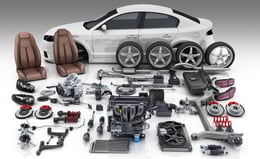S&OP in the Automotive Industry Requires Integrated Order Management
Robin Hornung - December 06, 2022

In the automotive industry as well as in manufacturing companies, S&OP is considered as the central process that controls operations in any company. A reliable short- to long-term sales forecast of market demand is transformed into production plans to have an optimal resource utilization. Through good S&OP, the capacities of internal resources and the supply network are adjusted to ensure the supply of materials. However, with constantly fluctuating demands, it is not enough to just plan existing orders and forecasts. In the very variant rich and complex automotive industry, there are three main reasons why the order management and S&OP processes need to be closely integrated:
1. Inbound Supply Planning
For today’s OEMs, a large portion of their value generation occurs in the supply network, with upwards of 70% of parts coming from external suppliers. But this creates a major problem, as the supply network is often not integrated with the central planning process for final product assembly. Usually, this happens because the Bill of Material (BOM) requires fully specified orders before it can calculate part demands. Classic S&OP strategies are also not designed to plan down to the level of fully specified orders. But an S&OP plan on inhouse products is no longer enough for resilient planning. In today’s ever-changing world, S&OP must look beyond existing orders to consider also planned orders.
2. Sales Business for Automotive Manufacturers has Changed
In recent years, how cars are sold has changed dramatically. Most dealerships are focusing more and more on the customer experience and acting as more of a showroom for inspiration than a point for purchasing inventory. In line with these changes, when a customer purchases a car today, the dealer needs to provide a realistic delivery date based on current production. By constantly synchronizing the order pool, dealers can know what is in production, what is in transit, and what inventory is at local dealerships. Now, new purchases can be directly booked to an existing planned order at any stage in the order and production pipeline. Then, the order is automatically synchronized with the S&OP plan to provide improved order estimations.
3. Carbon Regulations are Targeting Automotive Companies
With evolving carbon emission laws and guidelines, it is crucial that sustainability is considered throughout the planning process. Planning for sustainability can be better achieved with orders specified to the parts level. In this way, production can be planned more effectively, and the product mix can be modified to fit sustainability metrics.
So, how do automotive manufacturers consider both these volatile production environments and increasingly customized orders without compromising their profits or sustainability?
As planning does not occur at the same level of detail as execution, the key to maximizing both is optimizing the planning process by considering not only the order level, but also the BOM.
Planned Orders can Close the Gap Between Planning and Processing
For automotive companies, the central planning object will then become the planned order.
The pool of planned orders will be permanently synchronized with the S&OP Plan and might also reach out far into the future. This order pool then consists of fully specified vehicle configurations that are loaded into a planning production program. The program will represent the customer requirements and include the parts requirements as a BOM as well as information such as CO2 production and expected order stability and flexibility. The key is that this planned order will look like a real order and can be scheduled into production systems, broken down into parts requirements, and eventually replaced by real orders in final processing. With a control loop, every change and adjustment to a real order will result in recalibration of the plan and corresponding processing. And as mentioned before, placing a real customer order only means exchanging a identical/similar planned order which leads to minimal needs for adjustments in the overall production network.
AI-Powered Planned Orders can Streamline the Planning Process
To make the process as efficient as possible, these planned orders will be generated automatically, using technically buildable product configurations. Using AI-powered methods, a large pool of potential orders will be automatically generated. For some OEMs this might lead to more than a billion possible configurations. Each vehicle order then includes its configuration, price, and sustainability metrics. flexis developed the Mix Optimizer for this process, which considers all the necessary capacities and limitations that could affect the planned orders (e.g. supplier capacities and inventory limitations). To make an ideal mix for a given market and vehicle, a planner can use the Mix Optimizer to select the product, market, and time period to create a custom order pool. The highlight of this process is the ability to add in sustainability criteria such as the carbon footprint into the planned product mix.
flexis Continues to Push the Boundaries of S&OP
With this new approach to S&OP, the flexis solution provides the efficiency and flexibility that modern auto manufacturers need for successful planning. With the Mix Optimizer, automotive manufacturers can ensure their planning closely aligns with the BOMs they will ultimately execute. The result is a more robust and resilient planning process that can support both profit and sustainability goals in an ever-changing supply environment.
INTERESTED?
LATEST POSTS
- Understand Circular Economy in The Manufacturing Industry
- How Can Industry 4.0 IT Integration Be Achieved Smoothly?
- The Significance of Order Sequencing in Discrete Manufacturing
- How to improve your Supply Chain Management: The Power of Control Towers
- Optimizing Human Resource Scheduling in Manufacturing: A Technological Approach



